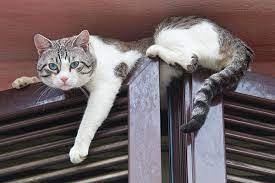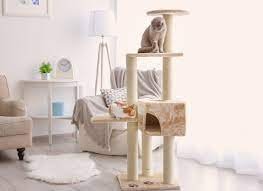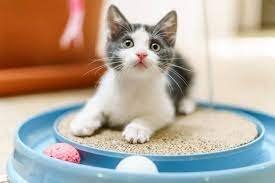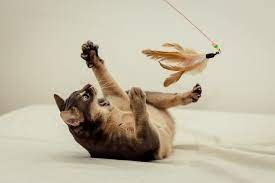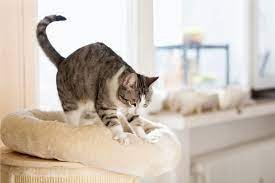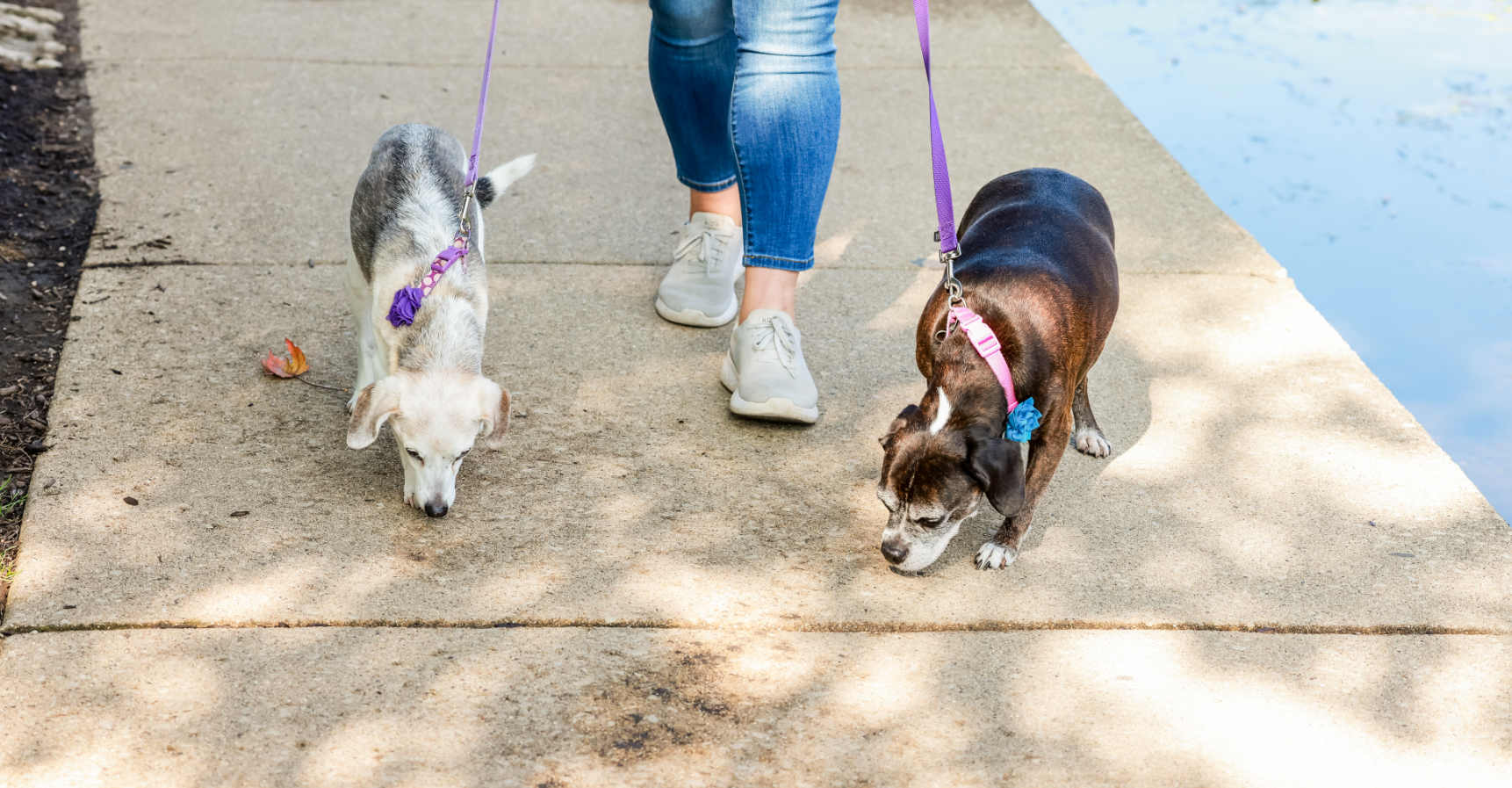
Blog
Asking For A Fur-Friend
Why Do Cats Like to Sleep up High?
We all know cats can be fussy creatures and this attitude extends to their sleeping habits as well. Many owners have gone out and bought plush, expensive beds only for their pampered cats to refuse to sleep on them. Are they just being fussy or is there an ulterior motive for this behavior?
We all know cats can be fussy creatures and this attitude extends to their sleeping habits as well. Many owners have gone out and bought plush, expensive beds only for their pampered cats to refuse to sleep on them. Are they just being fussy or is there an ulterior motive for this behavior?
Whether it’s the top of the refrigerator, a cat perch, the highest shelf on a bookcase, or the top of the cushions on the couch most cats enjoy being in high places and cherish those elevated locations. Your cat may feel more comfortable in the upper half of the room where they can keep an eye on the world around and below them with greater confidence. Instinct plays a huge role in determining feline habits and most cats prefer to sleep and hang out in places with good vantage points. This comes from their instinct to protect themselves and being up high gives cats the advantage of spotting potential dangers. Much of this comes from their ancestors since early cats were hunters that lived in the wild, and their ability to climb meant they had somewhere to retreat to away from larger predators in addition to giving them the ability to hunt for their prey high in the branches. Since this instinct has been passed down, this is why climbing and being up high is natural for our cats.
Cats may also prefer small, enclosed places, especially when sleeping. This also comes from their instinct to feel protected. Many cats, including my own, love to sleep in boxes that are enclosed on all sides. My cats even love it when I close the top, they can still get out, but they get some peace and quiet.
Once your cat finds the perfect place to sleep, they may be happy there for a bit. But do not be surprised if after a few months your cat switches places. The reason for this is only speculation, but experts think that it is driven by the fact that cats are notoriously clean animals; they dislike dust, dirt and even saturated smells. So if the area in which they were sleeping becomes too dirty or the scent changes, they will probably begin their hunt for their new favorite spot.
Let’s dive into details on some of the reasons our cats love elevated perches.
More Visual Warning Time for Your Cat
When your cat is perched high they can easily see more of their environment. The ability to see an opponent or predator entering the area can provide your cat with enough time to plan their escape, remain quiet and hidden, prepare an attack or determine the threat level of the approaching animal or human.
A Way for a Cat to Display Status
In a multicat environment, a higher ranking cat may choose the highest elevated location to display their position within a grouping. When there is tension between cats, the higher ranking cat may assume an elevated position to show status which can thwart off a cat fight.
Out of Reach
If you have a household with cats along with dogs or children, the ability for your cat to retreat to a high perch is the best way for them to be left alone. They may find a place where people and dogs cannot reach them and they can nap in peace.
Exercise and Playtime
If you have a cat tree that has multiple perches, this allows your cat the benefit of being able to climb, jump, and play on the structure. This can be even more true for an indoor cat. Placing a cat tree near a window is the perfect spot for your cat to keep an eye on prey activity happening outside. Even though they won't be able to get to the prey, it becomes a form of cat TV for your feline friend.
Warmth
Even warm and cozy beds can become a chilly place for our cats if placed on the floor. The floor can be drafty and chilly for your feline friend. Perches and beds located on top of cat trees or elevated off the floor are farther from the draft and closer to the rising warm air.
Choosing the Right Perch or Tree for Your Cat
While cat-specific furniture is becoming more and more popular, most of those are made to please the human eye and are less likely to take felines into account in the design. Perches need to be large enough for your kitty to sit on without having their back end or a leg hanging off. If your cat cannot fit on their perch or tree, they may feel it’s a vulnerable spot and may not enjoy being in that spot. Trees and perches that are “U” shaped or have a lip are great since your cat can lean against it. This can give your cat a sense of being protected, having their back up to a wall or ledge. Always take your cat's size and the way they enjoy curling up to nap into account when purchasing trees and perches.
Accommodate Seniors and Mobility Challenged Cats
Your cat should be able to enjoy perches and trees throughout their life. Provide steps for cats who cannot reach perches or other favorite locations. Look for cat trees with lots of platforms and perches so your cat can use them as steps to reach their favorite position on the tree.
Cats sleep a lot. Most cats will sleep up to sixteen hours a day, so make sure they have somewhere cozy and a place they feel safe to relax and nap.
If you are looking for care for your cats while you are away, consider hiring a professional pet sitter. If you are located in the Naperville, Elmhurst, Villa Park or Lombard, IL communities give The Pet Lady a call at 847.802.9534.
How Much Exercise Does Your Cat Need?
We know that exercise is crucial for our feline friends to keep them healthy and ensure good muscle and bone health. It can also help with your cat's coordination when they stalk, chase and attack their prey.
We know that exercise is crucial for our feline friends to keep them healthy and ensure good muscle and bone health. It can also help with your cat's coordination when they stalk, chase and attack their prey. Obesity in cats is a problem and engaging in play every day with your cat can help reduce their risk for being overweight. Another reason we need to make sure our cats are getting adequate physical play is that it leads to mental stimulation. Exercise helps avoid depression in humans, as well as in our pets, and studies show about 40% of cats suffer from this due to boredom. We know pets who do not have enough physical and mental stimulation can develop behavioral problems, which can be destructive, such as scratching furniture, chewing or being overly hyperactive.
On average, cats need about 30 minutes of physical activity every day. The amount of exercise required might also change depending on your cat’s age and whether they are indoor-only cats. Naturally, cats are hunters and respond to stimuli quickly. If you have an indoor/outdoor cat, while I do not agree with it, those cats who go outdoors require a different exercise regime than indoor cats do. Cats who venture outdoors have unlimited space to roam, they are more physically active and tend to get enough exercise naturally. Also being outdoors those cats are exposed to stimuli such as bugs and leaves which motivates them to perform stunts and be more active. Indoor cats have limited space and less exposure to natural stimuli unless they are like my cat, Phoebe, who finds spiders in the basement we didn't even know were down there. We need to make sure we are motivating our cats to participate in interactive games. You can do this by using toys like feathers, ropes and balls to keep them healthy. Engaging in play with your cat helps enforce the bond you have with your pet as well.
Whether your cat is older or is a young kitten also determines how much play they should have each day. Adult cats should exercise daily for at least a half an hour to keep their body fit and healthy. It also helps to keep their hunting skills sharp and provides the mental stimulation they need. On the flip side, kittens and young cats can sleep up to 22 hours a day, so they are naturally not as active as adult cats. Even though they are not as active, you should still exercise them daily with their favorite toys.
Fun and Easy Exercises for Indoor Cats
Bathtub Ball. With a dry bathtub, toss a ball inside. Your feline friend will be able to play freely inside the tub. Cats do not get bored easily when there are moving targets involved, so let them bat the ball around; you can join in and roll it for them to chase.
Laser Pointers. As we mentioned, cats love things in motion. You can use a laser pointer to keep your cat moving. To encourage your cat to play, use the laser pointer to move like a mouse or bug may move. Always remember to reward your cat after playing with the laser pointer, as there is not a tangible item they are catching; a treat can make up for it.
Animal Toys. Cats are very observant creatures and can somehow distinguish the physical appearance of real life and fake stimuli. Consider getting your cats toys that resemble real animals like birds, bugs and mice. To make it more exciting, connect a string to the toys and give the toys some life.
Ribbons and Wands. Tie a ribbon or string to the end of a wand and let your cats chase it around the house. These toys are great while you are engaged in play with your cat, but should be put away when the cat is alone to ensure they do not accidently choke on it.
Food Exercise. Mealtimes are very exciting and tempting for cats, especially when wet food is involved. We can help our cats hone their hunting skills by changing up the places where we feed them, or place the wet food in places they may need to climb or hunt for it.
Get Some Cat Towers. Cats love to climb and jump on things, so encourage them to use a cat tree instead of a couch or chair. Multi-tiered cat towers ensure your pet has lots of places to climb and play. To encourage your cat to climb or jump on their tree, place some treats on different levels to help them explore.
Try Catnip. Catnip and catnip toys are useful to help your cat to exercise. Your cat can have fun eating, rolling and being stimulated by the nip, but please note that some cats do not respond to catnip and some may become overly stimulated by it.
Introduce Leash-Walking. Much like training dogs on a leash, you can entice your cat to walk on a leash and harness outdoors. This can be a safe way to introduce your cat to the outside world. It is best to start young and slowly introduce the harness to your cat. Always make sure the harness is secure so your cat cannot wiggle out of it.
Get Your Cat A Pinata. Cats love batting at hanging objects. Putting kibble or treats in the pinata can motivate your cat to bat and play with the pinata. Your cat will be rewarded for their work as the treats drop from the pinata as your cat plays.
Match Exercise Partners. Unlike dogs, your cat may not respond to your requests to play or engage. You can consider adding a second cat as a playmate. They can get along well and engage each other in fun activities like chasing each other, wrestling or even cuddling.
So, overall, most indoor cats do not receive enough playtime and as pet owners, we should take the time to engage with our pets and ensure they get the physical activity they need. Choose games your cat enjoys or get to know which toys are their favorite. Even if 30 minutes does not fit into your schedule, any amount of vigorous play is great for our cats.
Why Do Cats Knead?
If you have a cat, chances are you’ve seen them making a rhythmic and repetitive motion with their paws on things such as pillows, blankets, the couch or even you. This is known as kneading.
If you have a cat, chances are you’ve seen them making a rhythmic and repetitive motion with their paws on things such as pillows, blankets, the couch or even you. This is known as kneading, which some loving refer to as ‘making biscuits’ or ‘making bread’ as the action resembles a person kneading dough. This behavior is completely normal in cats and it is an inborn behavior that kittens carry into their adulthood.
Let’s talk about why our cats knead.
Cats knead to feel comforted.
Newborn kittens gently knead their mother’s belly to help stimulate the flow of milk. This is an instinctual behavior and some cats may even dribble when kneading. As if they are drooling over the expectation of milk. While adult cats do not need to nurse, this is likely associated with comforting feelings. Cats may also purr as they knead showing you they are enjoying the feeling from kneading.
Cats knead to mark their territory.
Cats can be territorial creatures and may knead to help them claim their space. Cats have scent glands on their paws and kneading is a way of them leaving their scent in an area. They transfer their scent on whatever they are kneading and are also letting other cats know it is their space.
Cats knead to make the bed.
While kneading is tied to nursing, there may also be another instinct at play. They may knead on a surface to get comfortable before taking a cat nap - pun intended! The ancestors to the now known house cat, needed to flatten out and pat down resting and sleeping areas to make them more comfortable and detect any unforeseen hazards before sleep. So kneading may be a throwback to that ancient instinct.
Cats knead to show they like you.
Similarly to the way when a dog likes you, they lick you, cats can show their love in their own unique way as well. It is a compliment if a cat kneads on you, as it can mean that they are comfortable around you and they want to show their affection. And the more your cat loves you, sometimes the harder they knead. So sweet!
Cats knead to stretch.
Just as we need a good stretch once and a while so do our feline friends. When cats are kneading they outstretch their arms, simulating a good stretch. This action can help wake up muscles and stimulate circulation.
Cats knead to show they are going into heat.
If your female cat is not spayed, kneading might be an indicator that she wants to mate. Anytime your unspayed cat acts differently it can be a sign she is going into heat. There are also spayed cats who may exhibit the signals she is going into heat, but it is a false heat. Behaviors such as rubbing against you, being extra cuddly and affectionate or making different vocal sounds on top of kneading can tell you your cat is ready to mate.


